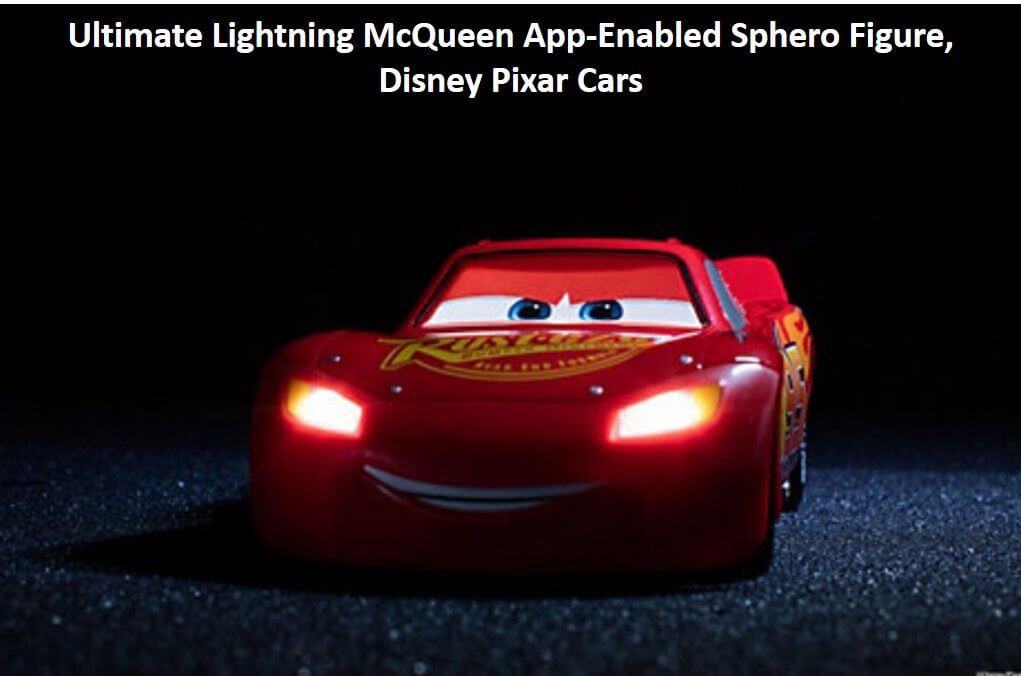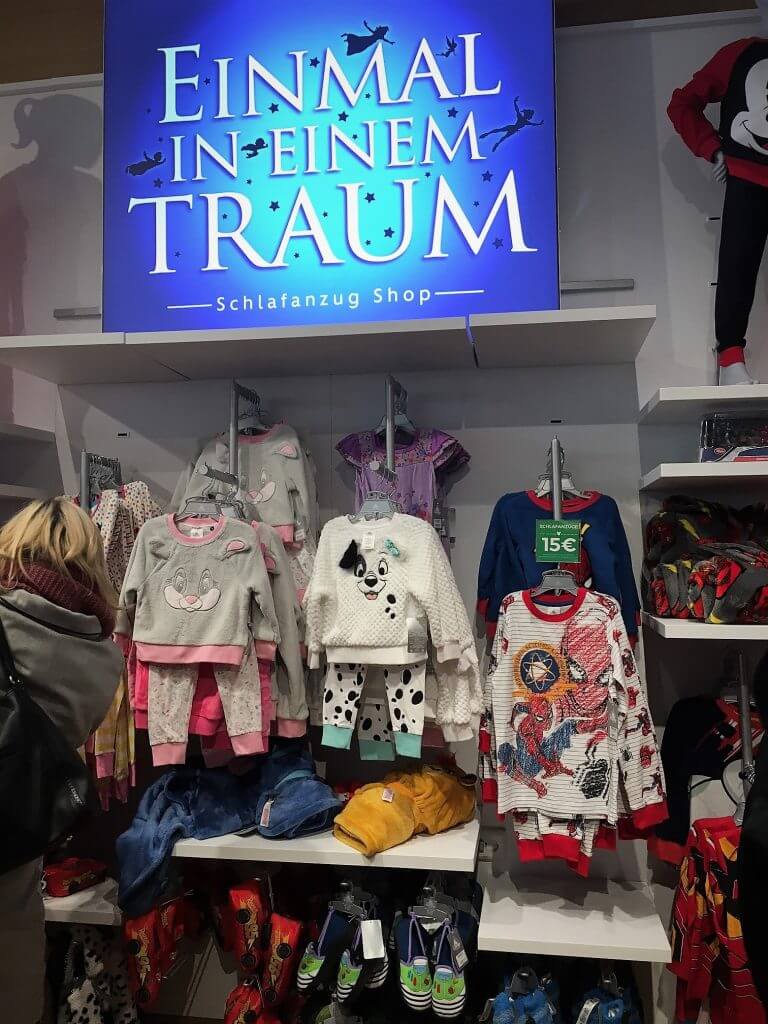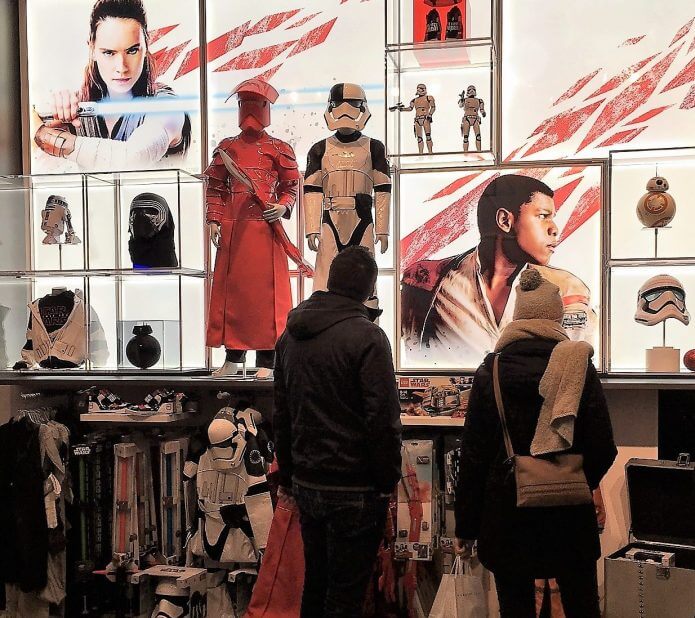Disney opened its first brick and mortar store in Germany three weeks ago. Let’s perform a retail survival check to guesstimate its chances of sustainable success!
Truth be told, it is not actually the first Disney store to ever open its door to magic in Germany. Disney ran four stores in the 90ies which, according to Disney, had to close due to licensing problems. With its new store on one of Germany’s busiest high streets, Disney starts a second attempt to conquer the German market with its merchandising products.
What Are the Success Factors?
Let’s have a look at some of the success factors which might help Disney to sustainably run a 300 sqm store on one of the most expensive shopping streets in Germany.
The Disney Brand – Awareness and Desirability
According to ‘Brand Finance’, Disney tops the list of the ten most powerful global brands, followed by Lego and L’Oreal. Nike ranks 6th and Coca-Cola, once the most powerful global brand, only ranks 8th nowadays.

Disney tops global brand ranking (Screenshot: Heike Blank)
Approximately 90% of all Germans know Disney and connect the brand name with positive feelings and experiences. The Disney umbrella houses infinite brands from Thor, Spiderman, The Avengers from the Marvel family up to Cars, Toy Story and Nemo by Pixar, Cinderella, Rapunzel, Winnie the Pooh, Arielle and of course Mickey Mouse and Minnie from Disney, not to forget Star Wars and many more. With each new movie release, this brand family will further grow, bonding new consumers to the Disney brand.
Disney makes happy! Everyone has their personal Disney hero somewhere between Elsa the Snow Queen and the mighty Thor himself. People recall movie events with people they like, where they enjoyed immersing themselves in alternative worlds, facing adventures and having fun.
Germans know Disney, like Disney and associate Disney with positive experiences and – even more importantly – positive feelings. So we can tick off one of the most important elements of our retail survival check.
The Location – Neuhauser Street 39

Footfall at Neuhauser Street on a rainy afternoon (Photo: Heike Blank)
Munich’s Neuhauser Street (which is an extension of Kaufinger Street) guarantees high footfall. It is one of the most expensive shopping streets in Germany, generating the highest footfall among all German high streets. Unfortunately, this does not mean that it guarantees economic success of each store operating in this location. Due to extremely high rental fees, only a handful of brands are actually able to make money in 1A-locations like Neuhauser Street. Disney definitely has the potential to be among them.
We all know that footfall itself is not necessarily a success factor if the share of relevant footfall on total footfall is too low. For Disney, this won’t be a problem as literally everyone shopping at Neuhauser Street is a potential target consumer. Converting this potential into turnover, however, will largely depend on the store’s attractiveness, its assortment and how often people check it out.
Tourism
7 Mio visitors from all over the world come to Munich each year and spend on average 2 days in the city. Assuming that half of these visits to Munich are for Business purposes leaves us with 3.5 Mio tourists to potentially shop at Neuhauser Street. Disney now runs stores in 13 countries, but none in the Arab world and none in Russia or other Central and Eastern European countries, two regions which represent a big chunk of Munichs’ visitors from abroad.
But even for Chinese and American tourists, both of which have access to Disney stores in their home countries, the store offers unique products, for example, Mickey and Minnie wearing the traditional Bavarian costume of Lederhosen and Dirndl.

Micky and Minnie – the Bavarians (Photo: Heike Blank)
Choosing the right location might be the most important success factor of a retail store. For Disney, its current store location is almost a guarantee for retail survival.
Timing
The timing to open the ‘first’ German Disney store couldn’t have been any better. Disney’s brand awareness constantly increased over the last couple of years. And even more importantly, the real estate market is currently shifting from a seller’s to a buyer’s market with shrinking rental fees not only for new lease contracts. Big players like Zara and H&M are renegotiating existing lease contracts in order to balance shrinking footfall with lease reductions.
In the past 2-3 years almost all retail locations in Germany (perhaps with exception of Mac Arthur Glen outlets) experienced significant footfall drops – most of them even in the double-digits (see my earlier post). We all know the reasons: unification of high street locations, boring retail concepts, growing significance of online and mobile shopping, growing importance of other leisure time concepts and so on.
Chances are high that Disney already benefits from lower rents – an excellent precondition for retail survival in 1A-locations.
Product

Disney – entry price product (Photo: Heike Blank)
A desirable product that is accessible to a wide range of consumers, alongside constant innovation that keeps consumers interested in frequently visiting the store, is a key success factor for retail survival. Do I need to continue? Disney’s product flow is constantly fed by its movie, DVD, musical, toys and games releases. Disney closely cooperates with its licensees to ensure that product and featured brands and characters match. Disney invests a lot in product development and design to inspire its license partners. Unthinkable a couple of years ago: Disney now even offers products for customization by consumers.
Prices range from 4€ for a Star Wars themed reusable shopping bag to 349€ for an app-controlled ‘Lightning’, the hero from ‘Cars’. There are many products in the entry price range between 6 and 25€, which makes Disney products accessible to literally every consumer shopping at Neuhauser Street. Last but not least, product quality, in the past not always without its challenges, has increased significantly, making the Disney products a durable delight.

Disney’s app-enabled Lightning (Photo: Heike Blank)
Store Size
Surprisingly, the store has ‘only’ 300 sqm, which seems quite small given the multiple brand universe Disney wants to feature. Some consumers, particularly tourists who know Disney stores in other countries, might be disappointed by the rather small size of the store. However, this might turn out to be a smart move. Besides the obvious advantage of a lower rental burden, the small store will force Disney to frequently reinvent the store, keeping it attractive and always worth a visit.
Untouched Potential and Challenges

High merchandise density in Marvel corner (Photo: Heike Blank)
Store Look and Feel
Due to the small size of the store, merchandise density is quite high. Catering to the massive crowd storming the store since its opening, wall and mid-shop fixtures already passed their practical test.
In the Disney store, the product is the hero. Store and fixtures are designed to provide the optimal stage for it. With exception of the entrance (which features Christmas editions), walls and fixtures are white, which makes a lot of sense given the colorful product range. The walls are covered by panels holding the uprights with multiple slots to click shelves, front or side hanging bars etc. into. This allows Disney to frequently change floor layout and fixture set-up at a minimum effort.
The visual merchandising is a mixture of brand-, character-, category- and licensee-based presentation and forces consumers to check out the entire store in order to make sure they have seen all products featuring their favorite Disney hero.

Licensee based merchandise presentation (Photo: Heike Blank)
However, the store does not quite manage to transport the magic of Disney. The atmosphere that Disney and its related studios manage to create in the movies is nowhere to be seen or experienced in the store. But – back to our retail survival check – this does not prevent consumers from exploring the store and, even more importantly, from buying.
Consumer Interaction
The store is clearly designed to enhance self-service for consumers. I have counted six staff members: four were at the cash desk, one was refilling shelves and mid-shop fixtures, and one was entertaining the crowd at the entrance screen where people were queuing to commemorate their friendship or birthday.

BFF-celebration at Disney store in Munich (Photo: Heike Blank)
Thus, the only interaction between staff and consumers takes place at the ‘celebration wall of fame’, the kids’ actions at the screen in the entertainment area and the communication at the cash desk. Of course, you can learn a great deal about your consumers by in-depth analysis of sell-through. However, customer interaction remains an area for improvement.
Multichannel Features
There is most likely no other brand that has all the assets for a true 360º multichannel concept. Yes, the store offers special services like the store opening ceremony every day, birthday/no-birthday events, or marriage proposals. The store features a special kids entertainment area with a big touch screen, small tables and seats and the opportunity to puzzle, select movies on the screen and so on.
But the connection between the different media like movies, games, musicals, online/mobile store and brick and mortar is negligible. There is quite some potential to withstand the retail survival check in the long run by using more multichannel elements such as:
- Information about additional product ranges from license partners not available in store;
- QR-Codes on each product, linking the product to its brand family online (showing next movie/DVD-release, offering tickets for musicals or special events, announcing the release of new products etc.);
- Online order or home delivery of larger and heavy items;
- Getting invitations to celebrate your birthday in store for online consumers;
- Exclusive collectibles in store triggering follow-on collectibles online etc.
Platform for Disney’s license partners

Disney Licensee C&A – Store in Munich (Photo: Heike Blank)
Disney did learn from its earlier German retail adventure. A big part of the assortment is exclusively produced for the Disney stores (on- and offline). This makes it easier to control buying and allocation, bestseller management and replenishment. It limits Disney’s dependence on the reliability (quality, delivery service, etc.) of its license partners. And it allows a faster and more direct integration of learnings from consumer interaction into the development of new products.
One of the big challenges of Disney however, is to create a true platform (on- and offline) to market and sell all Disney products of all its license partners. The first German store has not taken Disney any further towards that goal.
Retail Survival Check Verdict
Summarizing my store experience and our retail survival check: the store is, and will likely continue to be, a great attraction for German Disney fans as well as tourists. Its long-term success will depend a lot on the coordination of product and assortment with Disneys’s movie/DVD, musical and games releases. The frequency of new drops and making consumers aware that a new product has arrived needs to encourage return visits to the store.
Given the average rental fee (incl. utility cost) at Neuhauser Street, the store has to generate between 3.5 to 4.5 mio € p.a. (depending on Disneys’ negotiation skills) in order to be financially successful.
I have observed the store’s conversion rate for about 30min on a Thursday afternoon. And yes this might be due to the fact, that the store only opened a few weeks ago, that Christmas is getting closer and that it is the only one in Germany, but I counted a sensational conversion rate of 67%! Should the store manage to retain even half of that, there is no doubt that it passes the retail survival check with flying colors.
About the Author:
Heike Blank has worked for big organisations such as VF Europe and s.Oliver but also for niche brands such as Ecko Unltd. and Zoo York in top executive positions. Her extensive experience with opening and managing own retail, partner stores, concessions and shop-in-shops in 23 countries in Europe, the Middle East and Asia make her a true expert in international expansion. Heike excels at finding a brand-specific balance between customising and standardising the business model when conquering a new market. Please feel free to email her to discuss these topics, or learn more about her here.


